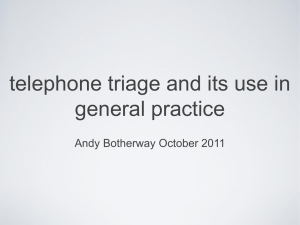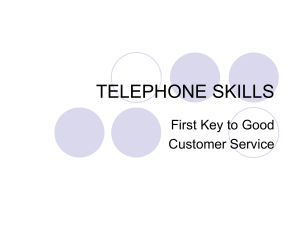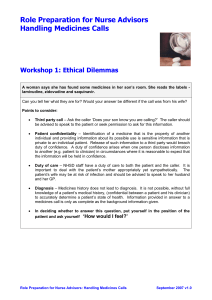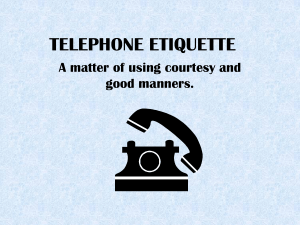Crisis Intervention
advertisement
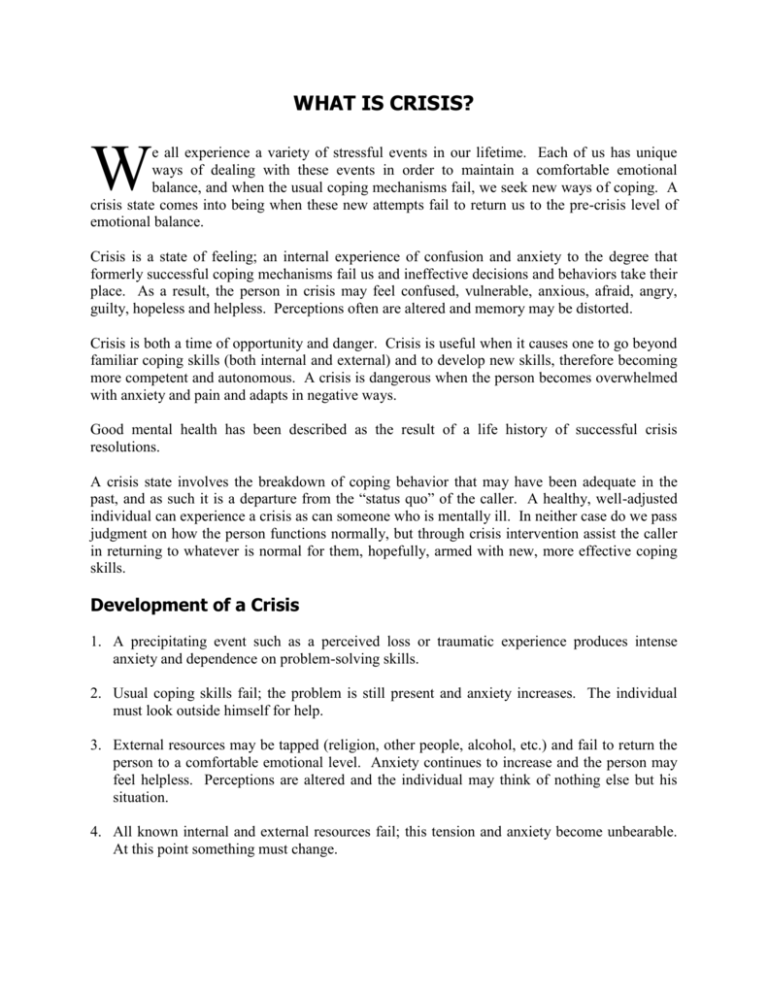
WHAT IS CRISIS? W e all experience a variety of stressful events in our lifetime. Each of us has unique ways of dealing with these events in order to maintain a comfortable emotional balance, and when the usual coping mechanisms fail, we seek new ways of coping. A crisis state comes into being when these new attempts fail to return us to the pre-crisis level of emotional balance. Crisis is a state of feeling; an internal experience of confusion and anxiety to the degree that formerly successful coping mechanisms fail us and ineffective decisions and behaviors take their place. As a result, the person in crisis may feel confused, vulnerable, anxious, afraid, angry, guilty, hopeless and helpless. Perceptions often are altered and memory may be distorted. Crisis is both a time of opportunity and danger. Crisis is useful when it causes one to go beyond familiar coping skills (both internal and external) and to develop new skills, therefore becoming more competent and autonomous. A crisis is dangerous when the person becomes overwhelmed with anxiety and pain and adapts in negative ways. Good mental health has been described as the result of a life history of successful crisis resolutions. A crisis state involves the breakdown of coping behavior that may have been adequate in the past, and as such it is a departure from the “status quo” of the caller. A healthy, well-adjusted individual can experience a crisis as can someone who is mentally ill. In neither case do we pass judgment on how the person functions normally, but through crisis intervention assist the caller in returning to whatever is normal for them, hopefully, armed with new, more effective coping skills. Development of a Crisis 1. A precipitating event such as a perceived loss or traumatic experience produces intense anxiety and dependence on problem-solving skills. 2. Usual coping skills fail; the problem is still present and anxiety increases. The individual must look outside himself for help. 3. External resources may be tapped (religion, other people, alcohol, etc.) and fail to return the person to a comfortable emotional level. Anxiety continues to increase and the person may feel helpless. Perceptions are altered and the individual may think of nothing else but his situation. 4. All known internal and external resources fail; this tension and anxiety become unbearable. At this point something must change. Possible Crisis Outcomes A person cannot stay in crisis. The body can’t stand the physical and emotional strain indefinitely. Either the situation will change and the person will return to a pre-crisis state; the person will develop new coping skills and resources; or the person will avoid crisis by substance abuse, mental or physical illness, a suicide attempt, or other destructive behavior. Some precipitating events can never be undone (such as in the case of rape or death of a spouse) and so the option of returning to a pre-crisis emotional state is not possible. Even where the situational crisis may be resolved, the caller’s range of possible experiences and feelings has been altered and denial may play a big part in any resolution that does not include growth and development of new coping skills. Types of Crisis Developmental Crisis is a crisis resulting from a normal life change (i.e. puberty, leaving home, marriage, birth of children, retirement). These are changes that are normal parts of life and can only be successfully transitioned through as one learns to cope with her situation. Situational Crisis is the result of the unexpected trauma such as losses, illness or displacement. Because of the unexpected shock, one typically experiences these events as more stressful. At times these developmental or situational crises can occur simultaneously, and when that happens the crisis is usually more disruptive. The Person in Crisis There is not a clear-cut description of a person in crisis. Below are some feelings commonly experienced by someone in crisis: 1. Anxiety – Any substantial threat produces anxiety that can be helpful in mobilizing us to defend ourselves against the threat through change, action, etc. However, too great an amount of anxiety can lead to confusion, poor judgment, immobilization, and self-defeating behavior. 2. Helplessness – Being faced with an external or internal situation that we are not prepared to face can leave one feeling vulnerable. Intense emotions may contribute to the experience of helplessness. 3. Anger – Anger may be directed at another person, an event, or at the self. 4. Shame/guilt – The person in crisis often feels incompetent and out of control. S/he may experience feelings that are not acceptable or usual to her/him. The pain may be further complicated by being ashamed of one’s plight. Volunteer Manual/ Section 3/ REV 02/17/16 2 5. Confusion – Crisis may interfere with one’s ability to think straight, problem-solve, or event accurately perceive one's experience. This distortion in itself may be frightening and the persons in crisis may fear s/he is “losing his mind”. 6. Fear – The fear may be of actual components and possible outcomes of the crisis situation, as well as of the powerful effects listed above. Helping the Person in Crisis We may begin to sense that a person is in crisis by the intense feelings of fear, anger, sadness, pain, etc. which s/he expresses. In addition to the feelings of the person in response to the painful event, there may be another group of feelings as a result of his reaction to being in crisis. For example, a caller may say, “I’m so angry I never want to see her again…but I should not feel this way”. Through empathic, reflective listening we accept the caller and his/her feelings and also identify and clarify the feelings. In a sense we say, “But you do feel that way and that’s ok”. Help the caller sort out what is going on, what the crisis is about. If the caller is talking loudly or wildly, the counselor may be swept up in his sense of urgency and react to the impulse to do something, to fix it before adequate information has been gathered or adequate relationship established. In such a case, the first step would be to get the person to slow down, to take his time, and to communicate our concern and willingness to help. It is also important to remember that options for the situation, if there are any, already exist. The counselor does not invent them and a thorough exploration is the initial step in discovering important feelings and information. In a crisis situation a here-and-now focus is helpful. It is highly unlikely that we can resolve a large or complex problem in one phone call, but we can help the person to reduce their level of anxiety to a more manageable level and to develop short-term plans aimed at beginning to work him/herself out of the crisis. The plan should be simple, concrete and behavioral (something he can do and see the results of quickly). Volunteer Manual/ Section 3/ REV 02/17/16 3 STAGES IN THE COUNSELING RELATIONSHIP STAGE I Establish rapport / Build a relationship Unconditional Positive Regard, Genuineness, Empathy Establish trust. Engage in Active Listening Reflect, reflect, reflect. . .feelings or thoughts Open-ended questions Attending behaviors: “Ear contact,” “mmm’mm,” “I hear you.” Tracking - responding to what he or she has just said. “Take your time”. Give permission to ventilate Silence can be a powerful form of active listening. STAGE II Clarification / Define the Problem Who is this person? What has made him/her call today? What is at the heart of the call/session? Break it into smaller pieces. Gather information. What does this problem mean to him or her? Reflect, reflect, reflect . . . Open-ended questions or closed-ended questions. Assess the situation for risk, emergency, or danger. Bring up a difficult subject. STAGE III Explore Resources Prior strains? Available resources? Perception of the problem? What has he/she tried before? What options does he/she see? Who can they turn to for support or help? What special considerations factor in to the resources? Facilitate his/her development of the solution or options. Refrain from giving advice! Let the caller do the work. STAGE IV Plan of Action See “SMART” Plan Pace him/her and yourself . . . “Rome wasn’t built in a day.” Break plan into manageable steps - Summarize. Anticipate problems The call may be resolved before it gets to action planning. STAGE V Wrap up the call/session How does he/she feel now? Commend him/her for making call - for risking. Offer the Crisis Center or other resources. If there is a special reason follow-up, plan and make clear. Give feedback. Volunteer Manual/ Section 3/ REV 02/17/16 4 COUNSELING “LEADS” Stage I Opening a call How may I help you? That’s what we’re here for. What would you like to share with me? Tell me about why you called today. What happened today to prompt your call? Reflection (Reflection will used A LOT!) You feel _____________ because ______________. I hear you saying _________________? What you seem to be saying is _____________? I feel _______ as I hear you. You must have felt ___ when ______happened Stage II Stage III Stage IV Clarification Help me to understand. Tell me more about that. How are you feeling? How do you feel about __________? I’m wondering if _________________? I’m not sure I understand. Can you repeat that? How long have you had this problem? Exploration of Resources What do you feel are your resources? Who do you have in your support system? What has worked well for you in the past? What do you feel able to do about this just for today? Who can you count on to assist you? What do you believe prevents you from resolving this? What would have to happen first? How do you see your problem resolving? How would you like things to be if you could have them your way? What things have you tried before? What do you see as the next step for you? Wrapping up a call/session How are you feeling now? What do you see happening after our call? It seems as if you’ve identified and explored your problem and now you have some things to reflect upon [or a plan to act on.] I want to applaud your courage for calling and for taking a chance on sharing your problem with me. I hear you having ____________ [specific positive assets] and I really believe in your ability. I want to wish you well. We need to break now, but good luck and thank you for calling. Volunteer Manual/ Section 3/ REV 02/17/16 5 Crisis Assessment and Intervention A caller in crisis may be experiencing some impairment of this usual level of functioning. It is important to assess the degree of that impairment of functioning and if the caller is in immediate danger (emergency risk). This assessment will determine how directive and involved we need to be with this caller. We do not want to further disable a caller by taking over for him; thus increasing his dependency on others. Nor do we want a dysfunctional caller to continue a downward, out of control spiral into a more serious crisis. In effect, we as counselors are trying to assess how much control we need to take with a caller in order to help him. We make this assessment by gathering relevant information. The following questions are useful in making this determination. Is the person able to carry on normal responsibilities: are they paying bills, attending work, school, caring for kids? Are they eating/sleeping normally? Is the caller catastrophizing? “No one cares”; “It’s hopeless”. Are there other behavioral indicators of distress: i.e. inappropriate laughter, hearing voices, can’t stop crying, inability to concentrate, make decisions, distorted perceptions of people, places, or things? Generally, the more “yes” answers the assessment reveals, the more dysfunctional the caller, and the more directive the intervention should be. Consider the following continuum when making your decision about intervention strategy. Volunteer Manual/ Section 3/ REV 02/17/16 6 Assessment of Client’s Emotional State 0----------------------------------------------------------------------------------------------------------------10 Very Functional Totally Dysfunctional Client is in distress but it is at a manageable level. Normal activities are not affected Client is over-whelmed by distress, which is seriously affecting their ability to make rational decisions, care for themselves or others. Counselor’s Style of Intervention 0----------------------------------------------------------------------------------------------------------------10 Non-Directive Very Directive Non-intrusive and respectful of caller’s ability to make decisions. Counselor is reflective, provides support, encouragement, clarification, and information Counselor takes control. Tell client what to do. Very here and now orientation. The other level of assessment, which occurs simultaneously, is the assessment of “emergency risk”. How likely is it that the caller will harm themselves or a third party? When, during a call, we as counselors become concerned that the caller might be at risk of harming themselves or someone else, we must ask very directly, “Are you thinking about hurting yourself or….?” If their answer indicates possible danger, then we must assess the “Emergency Risk”. Let the caller know that you are concerned for them and that you believe they are serious. The following questions are necessary in making an emergency risk assessment: Have you ever felt like this before? – Check history of assault. How did you handle it then? (Past behavior is good predictor of future behavior.) What is the plan? How is the caller planning to kill himself or a third party? Generally, the more clear the plan, the more serious the threat. Are you using alcohol or drugs? An intoxicated person is more likely to act impulsively. What is the precipitating event? Has there been a recent disruption of the relationship? i.e. divorce, break up, just discovered spouse to be unfaithful. Is the person threatening to kill himself after the homicide? Does the person have access to the means to carry off the threat? Volunteer Manual/ Section 3/ REV 02/17/16 7 Notice that we use close-ended questions. These make good assessment questions because they elicit specific information necessary to determine risk. The more yes answers you get, the higher the emergency risk. When a high emergency risk is assessed, the counselor should focus on reducing the risk. i.e. getting rid of the means, stop drinking, rally support system: family, friends, paramedics, police. If the life of a third party is threatened, we have a “duty to warn”. As mentioned earlier, crisis intervention should take place in very small steps, i.e. “I want you to take some deep breaths and let’s make a plan”. The plan should be short term and have a high probability for succeeding. Volunteer Manual/ Section 3/ REV 02/17/16 8 CRISES & EMERGENCIES COMPARED PSYCHOLOGICAL CRISES PSYCHOLOGICAL EMERGENCIES A crisis is a loss of psychological equilibrium. Many emergencies can develop from or involve a crisis. A crisis is longer lasting in duration than an emergency and does not include the risk of danger. In crisis, normal coping responses are insufficient to resolve the situation. An emergency is an abrupt, sudden situation in which there is an imminent risk of harm. Secondary attempts to cope are unsuccessful and the crisis is activated. There is a marked increase in anxiety, tension, agitation, depression or a sense of defeat. Activities of daily living (eating, sleeping, grooming, daily habits, etc.) become impaired or are impossible to carry out. Emergencies can potentially result in harm to self or others in four possible ways: 1. Risk of suicide 2. Risk of physical harm to another 3. Being in a state of seriously impaired judgment in which an individual is endangered (delirium, dementia, acute psychotic episode, severe dissociation, etc.) A person can not remain in crisis 4. Risk to a defenseless victim (such permanently. as a child or elder) The goal of crisis intervention is brief or The goal of emergency intervention is to short term counseling designed to stabilize remove lethality and reduce or eliminate and restore the individual’s functioning danger. at a normal and adaptive level as soon as possible. Volunteer Manual/ Section 3/ REV 02/17/16 9 STEPS TO TAKE DURING CRISIS INTERVENTION OR EMERGENCY CRISIS INTERVENTION STEPS Crisis intervention done well may occur within the next 24 hours and over the next several weeks. Frequent use of Stage 1. Stay in Rapport Building for much of the call. EMERGENCY INTERVENTION STEPS Emergencies demand an immediate, personal and flexible type of interview if a tragedy is to be averted. Go pretty quickly to Stage 4, Plan of Action after careful assessment. 1. Engage the caller in telling his or her story. Use open-ended questions. Learn how and why things have built up. 1. Contain and define the emotional turmoil of the caller. Use closed-ended questions, avoid reflection of feelings, and focus on facts. 2. Obtain an understanding of the meaning of the crisis for the caller, prior attempts at coping, and availability of support systems 2. Determine the degree of risk: 3. Assess for the presence of a psychological emergency. If yes, suspend crisis intervention and conduct an emergency intervention. a. Assess lethality: ask about it in a direct and straightforward manner. If no psychological emergency is present, resume crisis intervention. b. What is the level of intent? For example, on a 1-10 scale….? 4. Assess functional impairment (activities of daily living) and impulse control, ego strength, quality of relationships, etc. c. What is the viability of the plan? For example, access to a method, etc. 5. Take a personal history. Has this ever happened before? How did you cope with this before? How do other earlier difficulties spill over into this one? d. What is the likelihood that the client will act impulsively? (fuse builds up, a prior history of explosive conduct, etc.) 6. Normalize that feelings are normal for an abnormal buildup of strain and stress. Focus on coping strategies, support systems, referrals, etc. 3. Direct him or her to appropriate care and treatment, such as inpatient or outpatient medical care. Resolve problem and allay crisis. Volunteer Manual/ Section 3/ REV 02/17/16 10 DIRECTIVE AND NON-DIRECTIVE RESPONDING MINI-CASE STUDIES Remember, non-directive responding is very much like Stage 1-Rapport building, with active use of reflection, open-ended questions, ear contact, trust-building. Directive responding is used in emergency situations, with active use of emergency assessment, closed-ended questions, and a plan of action. Decide how you would respond to the following situations. Try to anticipate any problems that might arise in dealing with such issues, including management of your own feelings. 1. You receive a call from a young male whose initial comments seem to indicate extreme shyness and sensitivity. He states he feels very awkward around girls and is sexually inexperienced. He asks several informational type questions concerning female sexuality. Gradually you become aware that the caller is breathing more repeatedly and seems distracted. You suspect he is masturbating. Directive _____ or Non-directive_____ What would you do? _________________________________________________________ 2. A 17-year old male, angry with a teacher who he feels humiliated him in front of his classmates, calls to say he’s planted a bomb in the high school gymnasium. Directive _____ or Non-directive_____ What would you do? _________________________________________________________ 3. A young girl whose presenting problem is a suspected unwanted pregnancy reveals the father of the baby may be her brother. She refused to give any identifying information. Directive _____ or Non-directive_____ What would you do? _________________________________________________________ 4. A woman calls to say she is certain that her neighbors are physically abusing their children. She is a widow living alone and is fearful of any repercussions if she attempts to intervene by herself or if she reports it to the police. Directive _____ or Non-directive_____ What would you do? _________________________________________________________ 5. The past two calls you have answered have been from the same person—an adult female named Mary who wants to talk about her divorce that happened five years ago. At least one other co-worker on your shift has taken a call today from the same woman. She seems totally uninterested in doing anything about her problems of loneliness and depression but readily agrees to free the line when confronted with the (“Oh, of course—I’m just wasting your time.”) The phone rings again and it is Mary. Directive _____ or Non-directive_____ What would you do? _________________________________________________________ Volunteer Manual/ Section 3/ REV 02/17/16 11 6. A 36-year old male caller identifies himself as Joe Smith, a resident of 2345 Park Place. He calmly informs you that he intends to take a gun and shoot his ex-wife who is currently living with another man. He has obviously been drinking. Directive _____ or Non-directive_____ What would you do? _________________________________________________________ 7. You receive a call form an obviously angry woman who says a Crisis Center counselor has mistreated her the night before and she wants to file a complaint with the Executive Director. She demands his home phone number. When you say you will have to take a message and have him return the call in the morning, she becomes furious and is verbally abusive toward you. She says she will call the newspaper and tell them what a shoddy operation this is unless you comply. Directive _____ or Non-directive_____ What would you do? _________________________________________________________ 8. The past three times you’ve worked your shift, a caller by the name of Ann has requested to speak with you specifically. She is a 16-year old who, according to the Crisis Center records, has occasionally been suicidal. She tells you that you are the only one who really seems to understand and care about her. Whenever you mention anything about other counselors who can help her, she becomes very despondent and starts talking about how nobody loves her. Directive _____ or Non-directive_____ What would you do? _________________________________________________________ 9. A caller whose presenting problem has been loneliness and social isolation begins asking you personal questions, e.g., “Are you married?”, “What do you do for a living?”, “where do you go to church?” Directive _____ or Non-directive_____ What would you do? _________________________________________________________ 10. A caller requests a referral to a therapist for treatment of her depression. After giving her several names, you find out she is already in therapy but feels misunderstood and uncared for—“He only cares about my money. He’s just not very warm. All he does is say, ‘uh-huh, that must be very hard for you’ for a solid hour. It’s a waste of time!” Directive _____ or Non-directive_____ What would you do? ___________________________________________________ Key: Items which would likely result in a Directive response: 1, 2, 4, 5, 6, Items which would likely result in a Non-Directive response: 3, 7, 8, 9, 10 Volunteer Manual/ Section 3/ REV 02/17/16 12 WHEN CALLS BECOME DIFFICULT The three telephone counseling programs take over 30,000 calls per year, and some of those calls are bound to be difficult. What makes a call difficult? A high intensity crisis, a caller who is very dependent or helpless, a caller whose problems are too close to our own, a caller who needs services from a different type of agency? The Deed vs. the “Do-er” Challenging calls (deeds) are sometimes referred to as difficult callers (do-ers). There’s no denying that, when working with the public, there are bound to be some “customers” who are “difficult.” But crisis centers strive to understand and assist callers who may have problems which test the usual helping responses that we are trained to offer. Sometimes these callers are referred to as repeat callers, consistent callers, chronic callers, or line abusers. As one experienced staff member stated, “The difficult part of chronicity, is trying to determine if the caller has some form of mental illness and whether frequent contacts with the Center help to keep him or her stabilized, or, if the caller is using us as a “stop-gap” measure instead of getting the therapy or help he or she really needs….Our challenge is to “determine if the repetitive call is productive or harmful to the caller.” It is important that we as skilled helpers assume the burden of appropriate helping with an “untrained caller.” The caller may have no idea that he or she is inappropriate or mismatched to our services. He or she may have little success with social skills and discernment and is doing the best he or she can when deciding to call the center. We hope that people are able to function as well as possible in the “real world” but when they cannot, we also cannot expect them to screen and refer themselves to more appropriate agencies or helpers. That is part of the thrill of serving a crisis line: one never knows who or what type of problem will be at the end of the line! It is important that we respect the caller, the “do-er”, even if we are struggling with the way he or she uses or abuses (the deed) the line. We are urged to provide the same core conditions of helping to each and every caller, no matter how he or she “makes us feel”. Challenging callers arouse our feelings of frustration, irritation, anger, revulsion, inadequate, confused, abused and exhausted. Our challenge (or responsibility) is to extend unconditional positive regard, warmth, empathy, and congruence to each caller, even when we have these types of feelings during the call. Volunteer Manual/ Section 3/ REV 02/17/16 13 CHARACTERISTICS OF A REPEAT CALLER Caller has persistent, even chronic problems. Caller has many problems. Caller may be mentally ill or have protracted psychiatric difficulties. Caller may experience confusion about what the “presenting problem” is. Caller may not know or will express in vague terms the precipitating event. Caller may be in a state of anxiety, low or high. Caller may talk nonstop, or the counselor may feel as if s/he is “pulling teeth” Counselor may feel as if he or she is working harder than the caller is. Caller may shift responsibility to the counselor. Caller may ask for advice. Caller may ask the counselor to self-disclose. Caller may say, “Yes, . . . but, . . .” to many of the counselor’s responses or suggestions. The caller may have difficulty in receiving help. Counselor may find it difficult to end the call. The termination of the call may lack a clear plan of action. Counselor may feel as though reflective listening does not seem effective. Counselor may feel frustrated or confused. Caller may become manipulative, or may escalate “symptoms” in order to keep the counselor on the phone. What’s a Counselor to Do? While we uniformly offer the core conditions of counseling to each caller, we might also handle these difficult calls with more specialized types of responses that are unique to a caller who may be “stuck” in a cycle of chronic problems. With the many stages in a call, keep these sample responses and ideas in mind as you attempt to identify/clarify the presenting problem, assess the situation, set limits, refer to other resources, reframe, intervene, and terminate the call. Identifying the Problem “What prompted you to call today?” “How can I be helpful to you today during our conversation?’ “What specifically is troubling you?” “When you thought about calling the Crisis Center, what was your hope about how the Center could be helpful?” “What issue would you like to discuss today?” “Of all the things that you’ve mentioned, which is one that we could talk about today?” Assessing the Situation “What have you done about your problem since the last time you called the Center?” “Who else might you be able to talk with about your problem (counselor, therapist, doctor)?” “How is your therapy proceeding?” Volunteer Manual/ Section 3/ REV 02/17/16 14 “What is it that prompted you to call specifically at this time (as contrasted with last week or last month, year)?” “On a scale of 1 to 10, with 10 being ‘horrible’ (or urgent, or panicky, or ________) and 1 being great, what number would you say best describes your difficulty?” “What is the obstacle that keeps you from taking charge of things?” Reframing the Call Counselors are urged to “reframe” the helplessness or dependency of a particular caller by using encouragement and intentionality. Accentuate the positive. “Tell me what you’ve done since our last call.” “Tell me which referrals you called following your last call.” “What good things have happened?” “What have you thought of doing?” Intervening Support the feelings of the caller, not necessarily behaviors (such as frequent calling, attempts to seem helpless, etc.) “Go with” the caller; avoid trying to convince that he or she is wrong. Beat your caller to the punch in the “yes, but” dance...Caller: “I don’t know what to do.” Counselor: “Yes, but if you did know, what would you want to do?” Help your caller to list pro’s and con’s of choices, consequences, etc. Facilitate your caller to “act as if” they could do something differently, just for one day. Encourage experimentation with new possibilities. Use imagery to help your caller imagine and visualize mental pictures of what certain outcomes might look like. Role-play. Avoid over-processing. Strike while the iron is hot. When the caller seems ready for action, go for it. Be supportive of any effort to change. Setting Limits “I regret to inform you that our agency cannot provide what you need. I’m glad that you felt you could explore this as an option.” “I believe in you and your ability to solve your problems. I fear that if we talk too frequently, (or for too long) that you will get the message that I think you’re helpless.” “We have found that we can be most helpful to you and others who share your problems if we focus and work very efficiently to give you the referrals that would best serve you.” “I’d like to honor you by ending our call on time.” Referring to Appropriate Resources “Your needs are outside of the services that we can provide to you. I am encouraging you to call _________(a therapist, hospital, mental health center, etc.) to get further assistance. I have a few phone numbers I could give you.” “I’m aware that you could be helped by someone other than the volunteers at the Crisis Center. Please take these phone numbers.” Volunteer Manual/ Section 3/ REV 02/17/16 15 “What you are talking about is not covered by our services. Let me give you the numbers of someone who could.” Terminating the Call “I’ve enjoyed talking with you, and I hope this conversation has helped you feel a bit better; I need to open up the line again.” “I will need to end the call now. Have a good day.” Or, “I need to hang up now.” “Our time is up. Have a good day.” “It’s time for us to wrap up. I’m glad you’re doing better.” “I’m going to have to free up the line for another caller now. Thanks for calling.” GENERAL GUIDELINES FOR WORKING WITH REPEAT CALLERS Short-term, focused crisis intervention model is usually not effective. Reflection, clarification, and open-minded questions do not seem to be effective. It is better to be direct, frank, gentle but firm. It is important to tune into the pattern. There is a theme behind the words, such as loneliness, helplessness, dependency, etc. The work with the caller should focus on specific, reality-oriented, here and now steps. Proceed in small steps; change takes a long time for repeat callers. It is important to set and maintain limits: length of call, call frequency, focus of call, etc. Consult the Frequent Caller bios in the Shift Management binder. It is important to maintain person-to-person interaction, as contrasted with letting the caller talk about other people or other volunteers/staff, etc. Encourage the development of other support systems. Support the caller’s pursuit of therapy. Avoid the caller’s attempts to get you to minimize the importance of therapy or to drag you into conflict with the therapist. Continue assessing for suicide risk. Continue to give a clear definition of what the Crisis Center provides as a service. Resist the urge to provide a service that the caller hopes you will give (friendship, dependency, collusion, etc.) Be comfortable with ending the call, if all of the above have been done, even if the caller is angry about it. Volunteer Manual/ Section 3/ REV 02/17/16 16 Recognizing and Counseling Effectively with a “Sex Caller” A “sex caller” is not the same as a prank caller who uses sexual words. A sex caller’s goal is sexual satisfaction, yet he/she still deserves Unconditional Positive Regard, Empathy, and Genuineness. The sex caller needs firm and fair limits, but not rejection or hostility. For KHL and TL, the biggest hint that this may be a sex caller is that the caller is an adult. Common Characteristics: 1. Voice tone devoid of emotion 2. Hesitation in speaking 3. Gives first name immediately/asks counselor’s name immediately 4. Asks personal questions about the counselor 5. Uses the word “embarrassing” frequently 6. 7. 8. 9. 10. Asks for counselor’s opinion about the “problem.” Gives detailed sexual descriptions Uses formal or anatomical language in describing sex acts Hangs up abruptly before the call is complete. Uses a “whispery” tone of voice Common Opening Lines 1. Can I talk about anything? 2. I’ve never called before. 3. I have an embarrassing problem. Suggest Caring Confrontational Responses: “I’m having trouble accepting what you’re telling me.” “We’ve spoken about this before.” “How did you hope that I could help you with this?” “There’s no need to go into detail. I know what you’re talking about.” “We are not trained to deal with sexual problems. Let me offer you the following referral of those who have training in this area of specialty.” Summary of Do’s and Don’ts: DO: Tell the caller why you are hanging up. Follow through with hanging up immediately after you have said you are going to do this. With care, confront and/or interrupt the caller. Put responsibility for the majority of the talking on the caller. Volunteer Manual/ Section 3/ REV 02/17/16 DON’T: Debate with the caller after you have said you are hanging up. Give sexual information or advice. Promise caller anything before you know what this promise will entail. 17 Difficult Call Exercise True or False _______1. As a telephone counselor, it is OK to become angry with a caller. _______2. When you suspect that the caller is masturbating, you should pretend this is not happening. _______3. The telephone counselor is responsible for initiating and maintaining conversation with callers. _______4. It is OK to transfer a call to another counselor if you find you are unable to listen and respond objectively. _______5. Because frequent callers abuse the service we offer, they can be considered fair game for any response the counselor wishes to make. _______6. Generally speaking, you should suspect any caller who uses swear words of being a prank caller. _______7. If you find yourself consistently exhausted emotionally at the end of your shift, you may be getting burned out. _______8. If you begin to feel extremely sad or depressed while counseling, chances are the caller is feeling that way too. Volunteer Manual/ Section 3/ REV 02/17/16 18

